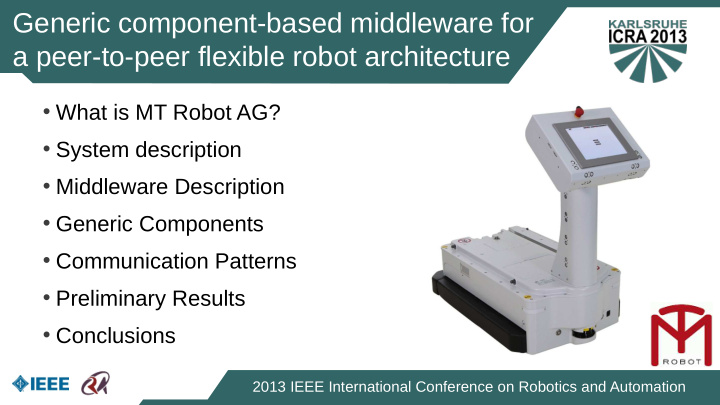



Generic component-based middleware for a peer-to-peer flexible robot architecture • What is MT Robot AG? • System description • Middleware Description • Generic Components • Communication Patterns • Preliminary Results • Conclusions 2013 IEEE International Conference on Robotics and Automation
What is MT Robot AG? • AGV manufacturer for health care and production/manufacture • Autonomous multi-robot navigation in existing logistic systems • Our system's characteristics are: – Flexibility and easy-to-install products according to customer needs – Scalability for extending software and hardware modules – Automatic response to system or environment changes UnitR 2013 IEEE International Conference on Robotics and Automation
System Description • Mission planning and execution for logistic operations • Multiple-resource allocation • Passive: resource reacts mechanically • Active: resource provides feedback (state) • Multi-purpose middleware for dynamic and inter-connected (generic) components • Measuring performance of a complex and changing structure • Near to real-time user interaction (GUI) • Customer extenuating environment conditions 2013 IEEE International Conference on Robotics and Automation
System Description 2013 IEEE International Conference on Robotics and Automation
Middleware Description • Basic functionality • Interfacing hardware and software components • Tasking processes (POSIX) • Managing middleware system commands Component communication: Inter-process communication TCP/IP Manage scalability and easy-to-deploy 2013 IEEE International Conference on Robotics and Automation
Generic Components • Message passing framework for inter-process and networked processes • Peer-to-peer like system • Minimalistic components as base of all programs • Efficient (how good?) vs Effective (how useful?) • Run-time configuration and data sharing • Defacto with continuously attachable capabilities 2013 IEEE International Conference on Robotics and Automation
Generic Components • Generic component characteristics: • Logging data remotely or locally (DB, files, etc.) • Brokerless process and node communication interface • Configuration based in data-dictionaries (meta-data) • Managing and reporting system performance (middleware commands) 2013 IEEE International Conference on Robotics and Automation
Communication Patterns • Multi-threaded mesh of interconnected processes and network distributed software components • E. g. algorithms, interfaces and drivers • Patterns organise a continuous flux of data streaming • Components compete for same processor or share same physical network • Architecture based in messaging patterns 2013 IEEE International Conference on Robotics and Automation
Communication Patterns • Request/response Synchronous or asynchronous two-way communication Multi-process „Hand- shake“ E. g. Client/Server 2013 IEEE International Conference on Robotics and Automation
Communication Patterns • Publish/Subscribe Asynchronous and filtered (topic) communication Message queue 2013 IEEE International Conference on Robotics and Automation
Communication Patterns • Pipeline Synchronising chains of processes with distinct execution time Allocate messages from parallel executed workers 2013 IEEE International Conference on Robotics and Automation
Communication Patterns • Exclusive pair Synchronously sent and reception of message passing Single connection 2013 IEEE International Conference on Robotics and Automation
Preliminary Results • Experimental platform: GenuineIntel 1.60GHz, 2065440k RAM and a network frequency 5.2 GHz. • Quantify performance of architecture • QoS like: • Connection state • Latency • Throughput • CPU usage and memory map 2013 IEEE International Conference on Robotics and Automation
Preliminary Results Latency (10 packets of 10 bytes) every 4s 1. Acceptable latency for this s d network n o c e s µ n i y a l e D 1. 2013 IEEE International Conference on Robotics and Automation
Preliminary Results Latency (10 packets of 10 bytes) every 4s 2. 1. Acceptable 2. latency for this 2. s network d n o c e 2. Robot s µ n navigating in i y a l remote area e D 1. 2013 IEEE International Conference on Robotics and Automation
Preliminary Results 1. Acceptable Latency (10 packets of 10 bytes) every 4s 2. 2. latency for this network 2. s d n 2. Robot o c e s navigating in µ n remote area i y a l e D 3. 3. Network traffic peaks 1. Iterations every 4s [2013-05-03 04:00:00-18:00:00] 2013 IEEE International Conference on Robotics and Automation
Conclusions • Interconnection of generic components of UnitR middleware • Multi-pattern messaging system • Adaptable components according to customer requirements • Provide quantitative measurements of architecture style 2013 IEEE International Conference on Robotics and Automation
Questions? • Renato Samperio, PhD • Senior Software Engineer • MT Robot AG , • Riedstrasse 16, • CH-4222 Zwingen • Tel: +41 (0) 61 775 20 23 • Fax: +41 (0) 61 775 20 21 2013 IEEE International Conference on Robotics and Automation
Recommend
More recommend